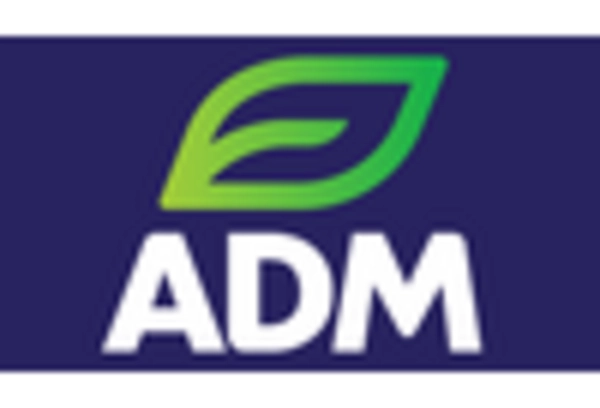The food anti-caking-agents market is characterized by a competitive landscape that is increasingly shaped by innovation, sustainability, and strategic partnerships. Key players such as Cargill, Incorporated (US), BASF SE (DE), and Ingredion Incorporated (US) are actively pursuing strategies that enhance their market positioning. Cargill, for instance, focuses on developing natural anti-caking agents, which aligns with the growing consumer demand for clean-label products. BASF SE (DE) emphasizes technological advancements in its product formulations, aiming to improve performance while reducing environmental impact. Ingredion Incorporated (US) is leveraging its extensive distribution network to expand its reach in the food sector, thereby enhancing its competitive edge. Collectively, these strategies contribute to a dynamic market environment where innovation and sustainability are paramount.
In terms of business tactics, companies are increasingly localizing manufacturing to reduce lead times and optimize supply chains. This approach not only enhances operational efficiency but also allows for better responsiveness to regional market demands. The competitive structure of the market appears moderately fragmented, with several key players holding substantial market shares. However, the influence of major companies is significant, as they set trends and standards that smaller players often follow.
In October 2025, Cargill, Incorporated (US) announced the launch of a new line of plant-based anti-caking agents designed to meet the rising demand for natural ingredients in food products. This strategic move is likely to position Cargill favorably among health-conscious consumers and food manufacturers seeking cleaner label options. The introduction of these products may also enhance Cargill's market share in the natural ingredients segment, reflecting a broader industry trend towards sustainability.
In September 2025, BASF SE (DE) unveiled a new digital platform aimed at optimizing the formulation of food additives, including anti-caking agents. This initiative underscores BASF's commitment to integrating digital solutions into its operations, potentially streamlining product development processes and improving customer engagement. The platform is expected to facilitate faster innovation cycles, allowing BASF to respond more effectively to market needs.
In August 2025, Ingredion Incorporated (US) entered into a strategic partnership with a leading food technology firm to co-develop innovative anti-caking solutions tailored for the snack food industry. This collaboration is indicative of Ingredion's strategy to enhance its product offerings through partnerships, thereby expanding its market presence. The partnership may also enable Ingredion to leverage new technologies and insights, further solidifying its competitive position.
As of November 2025, the competitive trends in the food anti-caking-agents market are increasingly defined by digitalization, sustainability, and the integration of artificial intelligence. Strategic alliances are becoming more prevalent, as companies recognize the value of collaboration in driving innovation. Looking ahead, it appears that competitive differentiation will increasingly hinge on technological advancements and supply chain reliability, rather than solely on price. This shift suggests a potential evolution in market dynamics, where companies that prioritize innovation and sustainability may gain a distinct advantage.

















Leave a Comment